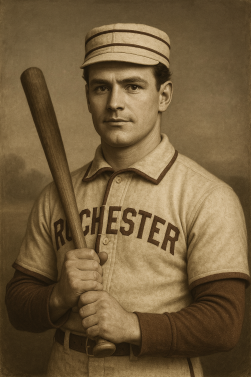The Federal League: 1881
“A Tie That Binds (and Divides)”
By its sixth season, the Federal League had grown used to chaos. Teams changed names, players jumped contracts, and magnates feuded in smoke-filled rooms. But 1881 introduced something new: a pennant race so tight it ended in a dead heat.
The Tie at the Top
 The Chicago Base Ball Club and the Cleveland Blue Caps finished locked at 55–28, their records identical down to the run columns. The two sides had split their season series, each claiming eight victories in sixteen meetings.
The Chicago Base Ball Club and the Cleveland Blue Caps finished locked at 55–28, their records identical down to the run columns. The two sides had split their season series, each claiming eight victories in sixteen meetings.
What followed was less a celebration than a governance crisis. As League President, Charles W. Garrison held the authority to decide the matter. As owner of Chicago, he also had everything to gain by breaking the tie in his own favor.
The newspapers howled about “a fox guarding the henhouse.” Some demanded a deciding series, others insisted on awarding the pennant to Cleveland on the grounds of superior run scoring (540 to 525). But Garrison, perhaps realizing that even he could not weather the storm of self-interest, declared both clubs co-champions. The precedent was awkward, the optics worse, but the tie stood.
A Dusty Trail Appears
If the boardroom was tangled in dispute, the field was graced with a new star. Paul “Dusty” Trail, a Scottish-born rookie with the Rochester Robins, electrified the league by batting .389 with 136 hits. Cranks quickly adopted him as their new darling, his easy swing and steady glove giving Rochester its first true gate attraction.
Behind him, familiar names filled the batting race. Chicago captain Morgan “Cap’n” Cook hit .358, proving that he was still one of the league’s premier hitters and baserunners. Cleveland catcher Bob Marshall followed at .355, his bat nearly as valuable as his defense.

Arms in Action
The mound was again a contest of giants. Cleveland’s Mike McCord posted 38 wins and a 2.67 ERA, cementing his reputation as the league’s steadiest workhorse. But the ERA title went to Louisville’s Ed Wales, whose 2.47 mark underscored his importance to the Colts’ surprising push into the first division.
New York, though fading in the standings, introduced an intriguing novelty in Tom Ewart. A true two-way man, Ewart hit .301 with 19 doubles, 7 triples, and 6 home runs, while also pitching to a 21–21, 3.08 ERA across 42 starts. He was, in short, the kind of all-around figure who belonged as much in dime novels as in box scores.
Final Standings, 1881
| Team | W | L | WPct | GB | R | RA |
|---|---|---|---|---|---|---|
| Chicago Base Ball Club | 55 | 28 | .663 | — | 525 | 375 |
| Cleveland Blue Caps | 55 | 28 | .663 | — | 540 | 369 |
| Rochester Robins | 44 | 39 | .530 | 11 | 468 | 454 |
| Louisville Colts | 44 | 41 | .518 | 12 | 426 | 385 |
| New York Columbians | 40 | 45 | .471 | 16 | 411 | 435 |
| Providence Planters | 39 | 46 | .459 | 17 | 412 | 489 |
| Milwaukee Creams | 32 | 52 | .381 | 23½ | 433 | 527 |
| Hartford Hawks | 27 | 57 | .321 | 28½ | 317 | 498 |
The Verdict
The year closed with two champions, one controversy, and one new star. To the cranks, the shared title was unsatisfying; to the owners, it was a reminder that governance mattered as much as base hits.
For Garrison, 1881 was a test of his authority. For Cleveland, it was a confirmation that their Blue Caps could match Chicago stride for stride. And for Rochester, it was the year a Dusty Trail led them out of obscurity.